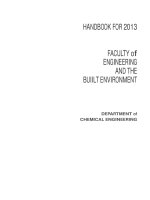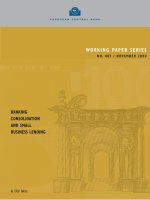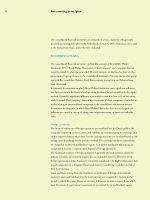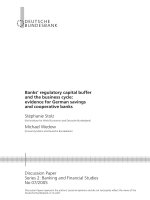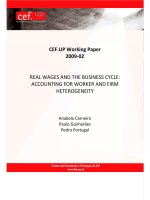Accounting and the Business Environment pot
Bạn đang xem bản rút gọn của tài liệu. Xem và tải ngay bản đầy đủ của tài liệu tại đây (233.74 KB, 46 trang )
Accounting and the
Business
Environment
Chapter
1
Objective 1
Use accounting
vocabulary
is an information system that
measures business activities,
processes information, and
communicates financial information.
Accounting
is called the language of business.
Accounting
External users
make decisions
about the entity.
Internal users
make decisions
for the entity.
Users of Accounting Information
Management Accounting
Financial Accounting
Fields of Accounting
Public Sector
(SEC)
Private Sector
(FASB)
Private Sector
(AICPA) (IMA)
GAAP
The Authority Underlying
Accounting
AICPA’s Code of
Professional
Conduct
Standards of
Ethical
Conduct of the
Institute of
Management
Accountants
Standards of Professional
Conduct
Proprietorships
Partnerships
Corporations
Types of Business Organizations
Proprietorships
✔
What are some advantages?
–
total undivided authority
–
no restrictions on type of business –
must be legal
✔
What are some disadvantages?
–
unlimited liability
–
limitation on size – fund raising power
Partnerships
✔
What are some advantages?
better credit standing – possibly
–
more brain power, but consultation
with partners required
✔
What are some disadvantages?
–
unlimited personal liability for general
partners
–
need for written partnership
agreement
Corporations
✔
What are some advantages?
–
separate legal existence
–
limited liability of stockholders
–
transferability of ownership relatively easy
✔
What are some disadvantages?
–
taxes – possible double taxation
–
extensive governmental regulation
Objective 2
Apply Accounting
Concepts and Principles
To provide information useful
for making investment and
lending decisions
Generally Accepted
Accounting Principles
✔
What is the primary objective
of financial reporting?
The Entity Concept Example
✔
Assume that John decides to
open up a gas station and
coffee shop.
✔
The gas station made $250,000
in profits, while the coffee shop
lost $50,000.
The Entity Concept Example
✔
How much money did John make?
✔
At a first glance, we would assume
that John made $200,000.
✔
However, by applying the entity
concept we realize that the gas station
made $250,000 while the coffee shop
lost $50,000.
Information must
be reasonably
accurate.
Information must
be free from bias.
Information must
report what
actually
happened.
Individuals would
arrive at similar
conclusions using
same data.
The Reliability (Objectivity)
Principle
Assets and services
acquired
should be recorded
at their actual cost.
The Cost Principle
The entity will continue
to operate in the future.
The Going Concern Concept
The dollar’s purchasing
power is relatively
stable.
The Stable-Monetary-Unit Concept
Objective 3
Use the Accounting Equation
Economic
Resources
Claims to
Economic
Resources
The Accounting Equation
Assets
=
Liabilities + Owner’s Equity
Assets
✔
What is an asset?
✔
It is something a company owns which
has future economic value.
–
land
–
building
–
equipment
–
goodwill
Liability
✔
What is a liability?
✔
It is something a company owes.
–
money
–
service – legal retainers
–
product – magazines
